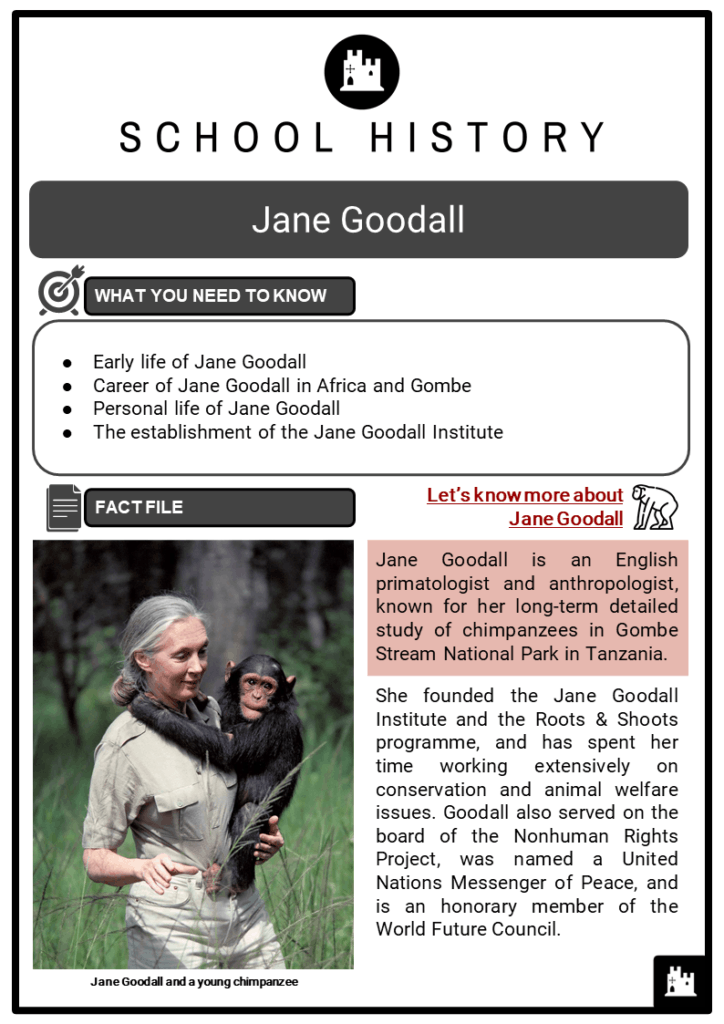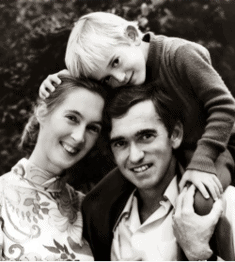Download Jane Goodall Worksheets
Do you want to save dozens of hours in time? Get your evenings and weekends back? Be able to teach Jane Goodall to your students?
Our worksheet bundle includes a fact file and printable worksheets and student activities. Perfect for both the classroom and homeschooling!
Table of Contents
Add a header to begin generating the table of contents
Summary
- Early life of Jane Goodall
- Career of Jane Goodall in Africa and Gombe
- Personal life of Jane Goodall
- The establishment of the Jane Goodall Institute
Key Facts And Information
Let’s know more about Jane Goodall
- Jane Goodall is an English primatologist and anthropologist, known for her long-term detailed study of chimpanzees in Gombe Stream National Park in Tanzania.
- She founded the Jane Goodall Institute and the Roots & Shoots programme, and has spent her time working extensively on conservation and animal welfare issues. Goodall also served on the board of the Nonhuman Rights Project, was named a United Nations Messenger of Peace, and is an honorary member of the World Future Council.
Early Life
- Valerie Jane Morris-Goodall was born on 3 April 1934 in Hampstead, London. Jane showed interest in animal behaviour from an early age, and treasured the stuffed monkey given to her as a toddler. She was reported missing at the age of around 4 or 5 but was later found in the henhouse where she was watching the hens lay their eggs.
- Goodall was fond of reading the Doctor Dolittle books by Hugh Lofting and dreamt of living in Africa to observe and write about animals.
- "Jane, if you really want something, and if you work hard, take advantage of the opportunities, and never give up, you will somehow find a way."
- During World War II, her father served as an engineer and after the war, her parents divorced. She graduated from the Uplands Private School in 1952 and proceeded to work as a typist as she couldn’t afford to go to university. Jane also worked part time as a film production assistant until in 1957, a family friend invited her to visit Africa.
Start of Career in Africa
- At the age of 23, Jane travelled to Kenya by boat on 2 April 1957. She enjoyed her time exploring the place and meeting new people. She also met the famous anthropologist and paleontologist, Dr. Louis Leakey. He believed that the study of great apes could provide indications of the early behaviour of hominids.
- Jane impressed Leakey with her knowledge of Africa and its wildlife so much that he hired her as his secretary. She then travelled with Leakey and his wife, archaeologist Mary Leakey, on a fossil-hunting expedition in Tanzania.
- “I could have learned a whole lot more about fossils and become a paleontologist. But my childhood dream was as strong as ever –somehow I must find a way to watch free, wild animals living their own, undisturbed lives – I wanted to learn things that no one else knew, uncover secrets through patient observation.”
- Leakey then helped Jane to earn her Ph.D. in ethology from Cambridge University. In 1962, Goodall was one of the eight people to have a doctoral dissertation at Cambridge without having an undergraduate degree.
Research in Gombe
- Louis then asked her to return to England to study primate anatomy and behaviour while he was raising funds for the proposed field study. On 14 July 1960, Goodall started to set up her camp at the Gombe Stream National Park in Tanzania, assisted by her mother Vanne.
- Observing the chimpanzees was a challenge as the animals fled from Jane out of fear. She searched the forest every day with patience and determination while trying not to get too close to the animals too quickly. Gradually, the chimpanzees accepted her presence. She also named the chimpanzees according to their behaviour:
- David Greybeard – grey-chinned male that first accepted her
- Goliath – friend of David Greybeard and the alpha male
- Mike – displaced Goliath as the alpha male due to his cunning and improvisation
- Humphrey – strong, big, bullysome male
- Gigi – big, sterile female that acts like an aunt for young animals
- McGregor – belligerent older male
- Flo – high-ranking female with her children: Figan, Faben, Freud, Fifi and Flint
- Frodo – second oldest child of Fifi, aggressive male who frequently attacked Jane and forced her to leave when he became the alpha male
- She observed behaviours such as hugs, kisses, pats and tickling, which were considered ‘human’ actions. These behaviours suggest that the similarities between humans and chimpanzees are more than genes alone and can be seen in intelligence, as well as family and social relationships.
- Jane’s observation that chimpanzees hunt for meat disproved the common belief back then that chimpanzees are vegetarian.
- Also, on 4 November 1961, she saw the animals using modified twigs to ‘fish’ for termites, which surprised a lot of people. It was the first time that an animal had been observed making and using a tool.
Marriage
- National Geographic sponsored Goodall’s work by sending photographer and filmmaker Hugo van Lawick to document her work at Gombe. Jane published her first article ‘My Life Among Wild Chimpanzees’ in August 1963. In 1965, National Geographic provided funds for the construction of buildings at Gombe that led to the establishment of the Gombe Stream Research Centre.
- Jane and Hugo then fell in love and got married in 1964. They had one son, Hugo Eric Louis van Lawick. However, the couple divorced in 1974.
- A year later, Jane married Derek Bryceson, a member of the Tanzanian parliament and director of Tanzania’s National Parks. Derek passed away in 1980 after a battle with cancer. His position in the government allowed him to protect Goodall’s research project and implement an embargo on tourism at Gombe.
Jane Goodall Institute
- The Jane Goodall Institute (JGI), which supports the Gombe research, was established in 1997. The JGI became widely recognised for its community-centred conservation and development programmes.
- Goodall founded the Tchimpounga Chimpanzee Rehabilitation Center in the Republic of Congo in 1992, to take care of orphaned chimpanzees. It houses over a hundred chimpanzees spread over its three islands.
- Jane founded Lake Tanganyika Catchment Reforestation and Education (TACARE or ‘Take Care’) in 1994, to protect the habitats of chimpanzees from deforestation by reforesting hills around Gombe. The project also educates neighbouring communities regarding sustainability and agriculture training. It also supports young girls in terms of reproductive health education and offers scholarships to finance their college tuition.
- The Jane Goodall Institute's Center for Primate Studies was created at the University of Minnesota to house and organise the handwritten notes, photographs and data piling up at Goodall’s home. The original archives of Jane have been digitised, analysed and placed in an online database.
- Jane Goodall has received a lot of honours and recognitions for her environmental and humanitarian work. In 2004, she was named a Dame Commander of the Most Excellent Order of the British Empire in an investiture in Buckingham Palace.
- Jane also received the Tyler Prize for Environmental Achievement, the French Legion of Honor, Medal of Tanzania, Japan's prestigious Kyoto Prize, the Benjamin Franklin Medal in Life Science, the Gandhi-King Award for Nonviolence and the Spanish Prince of Asturias Awards.
Image sources:









